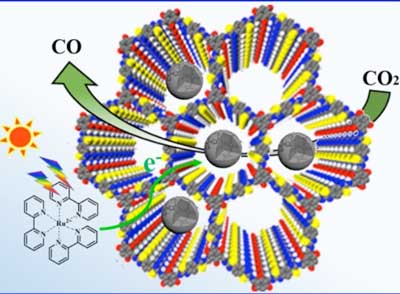| Aug 04, 2020 | |
Designing COF-based heterogeneous catalysts for selective CO2 photoreduction(Nanowerk News) The utilization of covalent organic frameworks (COFs) as heterogeneous catalysts for photocatalytic CO2 reduction has attracted significant attentions owing to their well-defined structure, high surface area and structural modularity. |
|
| However, most COFs-based catalytic systems require the presence of metal coordination units as catalytic active sites. The accessibility of metal-containing building blocks and crystalline difficulties have greatly limited the number of COFs-based catalytic systems. | |
| In a study published in Advanced Functional Materials ("Covalent Organic Framework Hosting Metalloporphyrin-Based Carbon Dots for Visible-Light-Driven Selective CO2 Reduction"), a research group led by Prof. WANG Ruihu from Fujian Institute of Research on the Structure of Matter (FJIRSM) of the Chinese Academy of Sciences presented the first demonstration of COFs hosting metalloporphyrin-based carbon dots (M-PCD@TD-COF, M = Ni, Co and Fe) for selective CO2 photoreduction. | |
 |
|
| A covalent organic framework hosting metalloporphyrin-based carbon dots serves as heterogeneous catalysts for CO2 photoreduction. M-PCD@TD-COF not only enriches available COF-based catalytic materials, but also provides suitable environment for CO2 adsorption and activation on metalloporphyrin-based carbon dots. | |
| The researchers developed a simple but effective protocol for rational design of COFs-based photocatalytic systems. These materials are readily fabricated through facile adsorption of molecular catalysts by COFs and subsequent pyrolysis. | |
| The method effectively solves problems of COFs in terms of crystalline difficulties and the limited metal-containing building blocks, which enriches the number of COFs-based catalytic materials. | |
| The importance of this protocol was highlighted by the enhanced activity of CO2-to-CO conversion, selectivity over H2 generation and durability of catalysts. | |
| COFs endow suitable environment for CO2 adsorption and the activation on metalloporphyrin active sites, thus allowing for efficient CO2-to-CO conversion of both pure CO2 and the simulated flue gas. The photocatalytic performance surpasses those in molecular analogues, which ranks it in the first class among the reported visible-light-driven photocatalytic systems. | |
| The demonstration of the feasible utility of the method in photocatalytic CO2 reduction provides a direction for the development of photocatalytic materials. | |
| The protocol for the integration of COFs and carbon dots not only solves problems in COFs-based photocatalytic systems, but also could be extended to a broad range of materials consisting of various COFs and guest catalyst materials for solar energy conversion and other applications. | |
| This study opens up a new avenue to develop more efficient COFs-based heterogeneous catalysts for photocatalytic CO2 reduction. |
| Source: Chinese Academy of Sciences | |
|
Subscribe to a free copy of one of our daily Nanowerk Newsletter Email Digests with a compilation of all of the day's news. |
